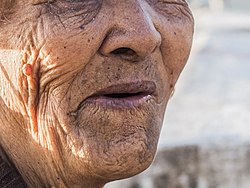Cyanosis
Cyanosis is a medical problem where the skin changes color. When a person has cyanosis their skin and mucous membranes turn blue or purple.
Cyanosis of the fingertips and nail beds. | |
| ICD-10 | R23.0 |
|---|---|
| ICD-9 | 782.5 |
| eMedicine | med/3002 |
Causes
Cyanosis is a sign that the cyanotic (blue) parts of the body are not getting enough oxygen in blood there.[1] This can happen because there is not enough oxygen in the blood. It can also happen when small blood vessels in the body get smaller because of a medical problem, which is called vasoconstriction.[1]
Manifestations
Cyanosis tends to be seen in the extremities the parts of the body that are farthest away from the heart. Usually, the first parts of the body to become cyanotic are the fingertips (especially under the fingernails), the toes, the lips, the tip of the nose, and the earlobes.[2] As the body goes longer without oxygen, more parts of the body become cyanotic.
Cyanosis Media
Child with congenital heart disease with central cyanosis that is worsened by measles. Note the bluish-purple discoloration of the fingernails, lips, eyelids, and nose, along with prominent nail clubbing.
Peripheral cyanosis in an individual with peripheral vascular disease.
An example of cyanosis in an individual with darker skin pigmentation. Note the pale purple (instead of the typical bluish-purple hue) nail beds. This patient also had prominent digital clubbing due to a congenital heart disease with right-to-left shunting (this patient had Tetralogy of Fallot).
Related pages
References
- ↑ 1.0 1.1 Dugdale, David (2013-04-21). "Skin discoloration - bluish". National Institutes of Health. Retrieved 2015-01-03.
- ↑ Lippincott Manual of Nursing Practice Series: Assessment. Lippincott Williams & Wilkins; 1 edition (2006) p.87 ISBN 1582559392
Other websites
| Classification | |
|---|---|
| External resources |







